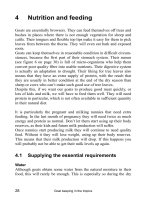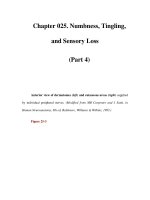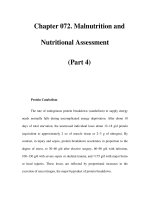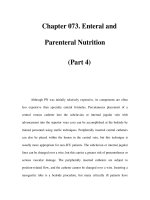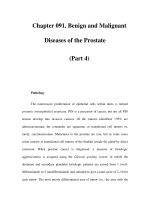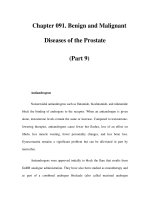Extreme Prematurity - Practices, Bioethics, And The Law Part 4 pdf
Bạn đang xem bản rút gọn của tài liệu. Xem và tải ngay bản đầy đủ của tài liệu tại đây (103.52 KB, 25 trang )
P1: KNR
0521862213sec2 CUFX052/Miller 0 521 86221 3 printer:cupusbw August 21, 2006 14:17
BIOETHICS
viewed this as “more than sufficient evidence of the disproportion-
ate burden that awaited this child to justify a decision to withhold
resuscitation.”(194)
This conclusion was made even thoughshould the infant have
survived, the statistical risk of a major disability was considerably
less than not having a major disability. Furthermore, should the
major neurological complications of extreme prematurity occur,
prediction of the degree of disability may be difficult, particularly
during the early stages after birth. Paris also proposed a “popular
fallacy” argument by stating that treatment is based on objective
criteria such as birth weight throughout Europe. Even if this was
totally true, which it is not as there is much variability (see Sec-
tion I), it is not a moral justification. He also wrote that because
the baby was described as “lifeless, hypotonic, hypoxic, purple-
blue, with no grasp or grimace, at birth,” that this should have
precluded resuscitation, even though the baby had a heart rate of
90. Many extremely preterm infants have this appearance at birth.
The reasoning that the baby’s appearance should have precluded
resuscitation begs the question, are infants such as these, who are
resuscitated at birth, more likely to have severe neurologic dis-
ability if they survive? Or, if they die, are they more likely to have
a long lingering dying process? The scientific literature appears to
support an answer of no to both these questions.(49–53,157)
Whereas considering the interests of the infant is paramount,
this is not to discount the interests of others. Parents who are
left to raise a disabled extremely preterm infant suffer significant
stress. They may enter a morass of frustration, guilt, denial, anger,
and disbelief that may be rekindled during their years of caring. It
should be argued that if the state has a strong duty to protect the
vulnerable and the susceptible, then it also has an obligation to
provide social, educational, psychological, and economic support
for those who care for disabled children.
66
P1: KNR
0521862213sec2 CUFX052/Miller 0 521 86221 3 printer:cupusbw August 21, 2006 14:17
BENEFICENCE AND NONMALEFICENCE
So it can be seen that principles may compete, and the inter-
pretation of their uses vary. Phrases such as best interests are difficult
to define for an infant, and it is arguable whether the use of such
a phrase can apply to nonexistence. Parents may find themselves
enveloped in myth and uncertainty. It is in such circumstances
that physicians, who may have little time or expertise in moral
argument, shape the discussions with parents and in effect deter-
mine the decision. This is not to say that physicians should not
impart their knowledge and wisdom to inform and guide parents.
Rather it is recognition of the prejudices and moral fallibility of all
involved and the slippery nature of moral standards and bound-
aries. Some might argue that physicians should stay within the
sphere of their technical and scientific knowledge. But the prac-
tice of medicine has never had this as its sole aim. The origin
of the word doctor is learned teacher, a sensei who is expected to
act like a priest and think like a scientist. Most physicians rec-
ognize this professional burden and may feel compelled, or duty
bound, to shape life and death decisions according to their moral
judgment.
67
P1: KNR
0521862213sec2 CUFX052/Miller 0 521 86221 3 printer:cupusbw August 21, 2006 14:17
17
JUSTICE
I
n general, the principle of justice concerns fairness and rights
and dictates that the extremely preterm infant should be treated
in the same way as other infants with the same treatable condi-
tion, for example, the extremely preterm infant and the full-term
infant with progressive hydrocephalus. This ethical principle pro-
tects certain moral rights even though, it can be argued, it may
conflict with the principle of beneficence.(195)AsFoot wrote: “an
act which is ‘more humane’ than its alternative may be morally
objectionable because it infringes rights.”(196)
Invoking justice as a principle can become arguable if it cannot
be agreed that the recipients of an action are equal in some agreed
on respect. Another form of justice is distributive justice. This
refers to a fair and equitable distribution of resources. It might be
argued that the costs of neonatal intensive care for the extremely
preterm infant, and the costs and burdens to society of providing
for disabled children, are not justified as they threaten the overall
welfare of society. If a justification is to be made for limiting such
neonatal intensive care on thesegrounds, then theproponent must
provide some measure of the social burden and compare it with
68
P1: KNR
0521862213sec2 CUFX052/Miller 0 521 86221 3 printer:cupusbw August 21, 2006 14:17
JUSTICE
other burdens that society agrees to take. The proponent would be
required to show that other accepted commitments such as mili-
tary defense, education, and other aspects of healthcare would be
substantially lessened. Costs are relatively small when compared
with some treatments in adults(2) and represent only a small pro-
portion of total health costs for children.(197)Ifresources are lim-
ited, it could also be argued that they are more effectively spent
on the very young than on the very old.(198)
69
P1: KNR
0521862213sec2 CUFX052/Miller 0 521 86221 3 printer:cupusbw August 21, 2006 14:17
18
S ANCTITY OF LIFE
I
n the Judeo-Christian tradition, the sanctity of life principle
might be stated as follows:
human life is of infinite value. This in turn means that
a piece of infinity is also infinite and a person who has
but a few moments of life is no less of value than a per-
son who has sixty years to live . ahandicapped indi-
vidual is a perfect specimen when viewed as an ethical
concept. The value is an absolute value. It is not relative
to life expectancy, to state of health, or to usefulness to
society.(199)
The sanctity of life principle is sometimes employed in such a way
that would suggest that the use of the words themselves should put
an endto moral argument,(200) what could be seen as an exchange
of reasoning for dogma rather than seeking an understanding of
what life is, when it has moral worth, and what the relative role
of other principles is. Even in a strictly religious context, in the
Western tradition, the need to sustain human life, purely because
70
P1: KNR
0521862213sec2 CUFX052/Miller 0 521 86221 3 printer:cupusbw August 21, 2006 14:17
S ANCTITY OF LIFE
it is that, is not overriding.(201–203) Glover defined the sanc-
tity of life principle as one in which taking life is intrinsically
wrong.(204)Heargued that the doctrine “is not acceptable, but
there is embedded in it a moral view we should retain.” He does not
argue that it is not wrong to take away life, but that “conventional
moral views about killing are often intellectually unsatisfactory.”
In the sanctity of life doctrine, the act of killing can never
have a justification, or there can never be a circumstance where it
is morally correct. It cannot be justified to save the life of another
or oneself. However, many would support the concept of deadly
self-defense, or the prosecution of a “just war,” but might not agree
with allowing nonterminal, severely handicapped infants to die.
71
P1: KNR
0521862213sec2 CUFX052/Miller 0 521 86221 3 printer:cupusbw August 21, 2006 14:17
19
A CTIVE AND PASSIVE EUTHANASIA
K
uhse wrote that killing is not always morally worse than let-
ting die and sometimes may be better.(205) She argued that
active euthanasia is morally no worse than passive euthanasia
and sometimes morally better. This, she stated, is based on the
motivation of the agent, as the two acts have the same outcome.
The actors, parents and physicians believe they are doing good,
which, in itself, is based on the notion that the outcome, death, is
good, or much better, than the alternative, a life with severe dis-
ability. Although the moral notion, in some circumstances, may
be seen by some as acceptable, it is based on an abstraction akin
to the legal term non actus reus nisi mens sit rea (knowledge of
the wrongfulness of an act at the time of its commission) and in
the case of foregoing life-sustaining treatment for an extremely
preterm infant, is not a verifiable proposition. Whereas the actors
may believe they are doing good, this is based on their percep-
tions and judgments, which have been molded by anecdote, bias,
prejudice, custom, and taboo. For example, it was not that long
ago that children with Down syndrome were left to die from con-
ditions that were correctable. Recent history is replete with acts
72
P1: KNR
0521862213sec2 CUFX052/Miller 0 521 86221 3 printer:cupusbw August 21, 2006 14:17
A CTIVE AND PASSIVE EUTHANASIA
performed by professionals that at the time were not believed by
them to be bad but would be judged as such now.(206,207) Thus
if a coherent argument for foregoing life-sustaining treatment for
an extremely preterm infant cannot be made on the basis of the
beneficence of the actors, nor on a verifiable outcome, if the life-
sustaining treatment is continued, can the action be considered
allowable? Apparently the action can only be good based on the
motivation of the actors, which is predicated on their belief in the
outcome. It would appear that an impasse has been reached. But
this is not necessarily the case for, while not disregarding the argu-
ments, it can be said that for ethical rules that determine behavior
to work there needs to be a degree of trust, both in the actions
of agents and in a reasonably foreseeable future. The former are
required morally to be virtuous, and the outcome is not required
to be absolutely verifiable. The physicians can agree on what is
required to be the actor, and what the outcome will be on a prob-
abilistic basis, and society, through its representatives are required
to take into account the fallibility of the actors, and the uncer-
tainty of the outcome. As Kuhse stated, “answers to public-policy
questions are rarely derived from first ethical principles, but are,
quite properly, based on common intuitions.”(205)
73
P1: KNR
0521862213sec2 CUFX052/Miller 0 521 86221 3 printer:cupusbw August 21, 2006 14:17
20
PERSONHOOD
A
ccording to Englehardt,(208)itismorally acceptable to allow
a severely disabled infant to die when it is unlikely that the
infant can attain a developed personal life, that is, become a per-
son, and when it seems clear that providing continued care would
constitute a severe burden for the family. He argued that there
is “an injury of continued existence”(208) and that a child has a
right not to have his or her life prolonged in those cases where
life would be “painful and futile.”(208)Hedoes not define futile.
He proposed that allowing a severely disabled infant to die is not
only morally acceptable but also morally demanded. Although
Englehardt used the principles of nonmaleficence – beneficence
and justice and preventing a continuing injury – removing a bur-
den from the family and the right not to have a painful futile life, as
well as suggested that there might be a universal law that demands
that a severely disabled infant be allowed to die, he also stated
that the attainment of personhood is important to the argument.
Singer defined a person as an individual who has rationality and
selfawareness.(209)Heasked if the life of a being that is conscious,
but not self-conscious, has moral value, and if so, how the value
74
P1: KNR
0521862213sec2 CUFX052/Miller 0 521 86221 3 printer:cupusbw August 21, 2006 14:17
PERSONHOOD
of such a life compares with the life of a person. Singer believed
infants arebeings that are neither rational nor self-conscious.(209)
They have not reached a neuropsychological standard required to
attain personhood, but will do so some time after birth. Tooley also
argued that to have a moral right to life a human should possess
those characteristics that identify that human as a person.(210)
He suggested that a person, in the moral sense, must be able to
envisage the future for itself and have desires about its own future
states. The personhood argument is that only personal life has a
unique moral claim to existence.(211)Ifthis characteristic, the
possession of higher brain functions such as self-awareness, ratio-
nality, and a sense of the future is accepted as the basis for a moral
claim to life, it does carry with it the weight of logical considera-
tion. However, in our society, this approach might be considered
counterintuitive and viewed as unreasonable by many.(211)
If one is to argue that the potential to become a person is the
criterion for claiming a moral right to life, and that this claim is
diminished in proportion to degrees of disability, then not only
does this presuppose prognostic accuracy, particularly in terms of
higher mental functions, it also suggests that there is a potential
personhood continuum that can be viewed in a categorical rather
than a continuous fashion. That is, there is some specific time in
development, normal or abnormal, when a person appears, rather
than viewing the continuum as a threaded chain that, if broken
at any point, destroys that chain. There is, of course, a point at
which the continuum starts. This point starts when an organ-
ism will develop into a person given a normal course of events.
The potentiality argument is refuted by those who state that if
it is followed it leads to accepting that a sperm or an ovum are
potential people.(212) But a tree is not a table in the normal
course of events. There comes a time when the constituent parts
of a human come together to form an organism that unarguably
75
P1: KNR
0521862213sec2 CUFX052/Miller 0 521 86221 3 printer:cupusbw August 21, 2006 14:17
BIOETHICS
has the developmental potential to become a human person. The
constituent parts, and their origins, do not, in themselves, have
this potential. I do not argue when this occurs, but it is certainly
present after birth.
If the reasoning of those who champion a neuropsychological
standard for personhood, which they argue will appear in infants
at some ill-defined time during their development, is followed,
then unless there is absolute certainty that this will never occur,
and there is often uncertainty concerning this, then a certain time
period will need to be determined before life-sustaining support is
removed from a disabled infant. It might be argued that the con-
cept of personhood, or potential personhood, should not be used as
the sole determinant for foregoing life-sustaining treatment from
a disabled infant in the absence of more rigorous ways of defin-
ing and recognizing its presence. In addition, this notion of self
that grants a person rights and duties does not necessarily remove
moral consideration from a nonperson. Many cannot justify cru-
elty to animals but have no qualms about considering exterminat-
ing cockroaches with noxious substances. Perhaps we allow moral
consideration based on a tier of situational acceptability that is
built according to moral consensus. Qualms are moral intuitions.
That is, they are doubts and uncertainties concerning what is right
or wrong, in a particular situation, without reasoning.(213) These
intuitions may vary between people and will depend on knowl-
edge, preconceived notions, and cultural education. In addition,
an intuition will depend on the language used to deliver a propo-
sition. So there may be qualms when the statement is we need
to kill this baby because it is a burden to itself and others, but
it may be more acceptable to state that it is in the best inter-
ests of the baby, and secondarily for others, to let this baby die.
The response to these statements is still intuitive, as the words
burden and best interests are not defined, reasoned, or argued. An
76
P1: KNR
0521862213sec2 CUFX052/Miller 0 521 86221 3 printer:cupusbw August 21, 2006 14:17
PERSONHOOD
intuition is sought rather than a moral truth based on theory or
principle. In such a situation, agreeing with one of the propositions
may be counterintuitive. The first requirement for testing moral
intuitions, whatever language is used, is acceptable fact, and only
then can moral theory and principle be applied. If the conclusion
is still counterintuitive, then there should be a reexamination of
whether facts are incorrect or whether reasoning or principles are
inconsistent. An example could be that moral status is granted by
an arbitrary definition of personhood. This definition then deter-
mines that an infant does not have moral status and a right to
life.
The definition of a person comes from Locke in the 19th
century, who wrote that a person is “a thinking intelligent being
that has reason and reflection and can consider itself as itself, the
same thinking thing, in different times and places.”(214)
This person, human or otherwise, has moral status with rights,
duties, and obligations. Those without this rationality and self-
consciousness are not entitled to this moral status. This neurolog-
ical standard, if followed logically, would lead to an unacceptable
conclusion, for example, that it is morally acceptable to experi-
ment on human newborn infants – nonpersons – to study disease
in adult gorillas – persons. This does not necessarily mean that
the converse is morally acceptable – experiments on primates to
benefit babies. Clearly, however, we do practice speciesism, even
though it may not be morally justifiable. So do those who propose
a personhood argument to justify foregoing life-sustaining treat-
ment for an extremely preterm infant propose something that is
counterintuitive and morally absurd? Is it because they equate a
right to life with moral status and moral status with personhood? It
seems that the argument centers on moral status. It could be argued
that we should grant moral status to those with both continuing
consciousness and developmental potential, and not necessarily
77
P1: KNR
0521862213sec2 CUFX052/Miller 0 521 86221 3 printer:cupusbw August 21, 2006 14:17
BIOETHICS
just rationality. It may be arguable just how much, or the degree of,
consciousness an extremely preterm infant has, but in biological
terms the infant is not just a brain stem preparation. If we grant
the infant moral status then we grant a right to life, and there are
duties that we owe the infant. In fact there are special duties that
physicians owe the baby, not only because of the degree of vulner-
ability and susceptibility of the baby, but also because the baby is
a patient. The baby deserves the dignity and respect that comes
with moral status. It is intuitively the virtuous thing to do, and it
would be morally wrong not to do so. Although the concept of per-
sonhood may be a long-standing topic among philosophers, who
argue what it is to be a person and gain moral status, the concept
has little if any practical application in the practice of managing
the extremely preterm infant. It would be highly unlikely that
anyone in this practice would consider that a living 24-week ges-
tation infant was any less a person than a 24-year-old, however
philosophically incorrect. That is, those decisions, including the
foregoing of life-sustaining treatment, ought not be made on the
basis of the moral worth of the infant. As Higginson wrote: “it
is not obvious that doctors have any special expertise that allows
them to presume to judge the ultimate value or significance of
another human life.”(215)
Thus the application of any personhood argument would
have no clear application given the real nature of clinical deci-
sion making and would be out of social context. That is not
to say that the concept of personhood is unworthy of examina-
tion. That is up to the philosophers. But it is to say that, in
all likelihood, the concept would be rejected by others actually
involved in the clinical situation. Other reasons and arguments
would be used, and the personhood argument would be rejected
on cultural grounds, which afford the most vulnerable, human
dignity.(216)
78
P1: KNR
0521862213sec2 CUFX052/Miller 0 521 86221 3 printer:cupusbw August 21, 2006 14:17
PERSONHOOD
It is a powerful general view that the life of an infant is a very
highly placed value, and the death of a baby is a sad and unde-
sirable occurrence. Is there something in us, nonmetaphysical,
that places this high value on life and particularly on the life of an
infant? Neuroscientists have demonstrated that there are strong
neurochemical rewards, expressed as pleasure, but seen as activa-
tion of neurochemical pathways, that are triggered by interaction
with infants, and in particular our own.(217,218) This visualized
response is the passion aspect that is pitted against a reasoning
personhood argument. This is probably why the latter is coun-
terintuitive. The passion is not necessarily directed in favor of
life-sustaining treatment, but might be strongly felt when a par-
ent, or a physician, strongly believes that he or she may be severely
harming a disabled infant by allowing life-sustaining treatment.
As Wocial wrote: “ethics involves not only understanding
principles and respecting rights, but reasoning through deep emo-
tions.”(219)
With this may come moral distress that occurs when an indi-
vidual perceives that what he or she believes is the right thing to
do is obstructed in some way.(219)
However personhood is defined and described, it is not
the only basis for moral standing(220) and use of the term,
in arguments concerning foregoing life-sustaining treatment for
extremely preterm infants, does not appear to be operational.
79
P1: KNR
0521862213sec2 CUFX052/Miller 0 521 86221 3 printer:cupusbw August 21, 2006 14:17
21
QUALITY OF LIFE AND BEST INTERESTS
I
sittrue that the life of an individual with a severe disability
may be so difficult for that individual that should the oppor-
tunity arise, during early infancy, to extinguish the possibility of
that life, taking that opportunity is a morally good act and not a
morally harmful one? In the best interests argument it is held that
treatment for a severely disabled infant should be such that it is
based on a reasonable assessment that its benefits outweigh its bur-
dens. In this approach there is an acknowledgment that there is a
balance to be struck between the value of an infant’s life, and “a
life that, on balance, does not warrant aggressive treatment.”(211)
The proposal is that treatment of certain infants harms their inter-
ests. How can we judge this for infants who are unable to express
their interests? It is clear that someseverely disabled infants endure
painful surgical interventions, and medical complications, that are
performed and managed to improve, as well as sustain, their lives.
In terms of the interests of such infants, is the endeavor worth the
outcome? It is not the act that is morally indefensible, as we allow
medical and surgical interventions to be performed on others, and
attempt to alleviate their pain and maximize their outcome. Is it,
80
P1: KNR
0521862213sec2 CUFX052/Miller 0 521 86221 3 printer:cupusbw August 21, 2006 14:17
QUALITY OF LIFE AND BEST INTERESTS
then, the outcome that is nonbeneficial? That is life as a severely
disabled individual. The argument cannot be sustained for the
majority of disabled infants who will live lives of sentience and
individual significance. But what of the infant who is destined to
be profoundly retarded and multiply handicapped?
Robertson wrote that:
the essence of the quality of life argument is a proxy’s judg-
ment that no reasonable person can prefer pain, suffering,
and the loneliness of, for example, life in a crib with an IQ
level of 20, to an immediate painless death astandard
based on healthy ordinary development may be entirely
inappropriate to this situation. One who has never known
the pleasure of mental operation, ambulation, and social
interaction surely does not suffer from their loss as much
as one who has . . . life and life alone, whatever its limi-
tations, might be of sufficient worth oneshould also
be hesitant to accept proxy assessments of quality of life
because the margin of errorin such predictions may bevery
great even if the judgment occasionally may be defen-
sible, the potential danger of quality of life assessments
may be a compelling reason for rejecting this rationale for
withholding treatment.(221)
The argument is that we cannot truly objectively judge what a
profoundly handicapped individual might prefer. This was not the
way authors of a Hastings Center Report saw it.(222) They sup-
ported the use of a quality of life standard that, they stated, should
be made in reference to the well-being of the infant. They con-
cluded that it was in the best interests of an infant not to receive
treatment when continued life would be worse for the infant than
an early death. Foregoing treatment, they believed, would not be
81
P1: KNR
0521862213sec2 CUFX052/Miller 0 521 86221 3 printer:cupusbw August 21, 2006 14:17
BIOETHICS
unjust discrimination when the infant’s handicap was so severe
that there could not be a meaningful comparison with an other-
wise normal child. They did make it clear that any decision should
be made from the child’s perspective, but did not state how this was
to be determined, other than that there were certain states marked
by pain and suffering that could be viewed as worse than death.
They did allow themselves another option, but without dismissing
the best interests approach. They stated that they were proposing
not only a best interests standard, but also an alternative relational
potential standard, where it could be said that if an infant lacked
any present or future potential for human relationships, because
of severe neurological impairment, they could be said to have no
interests, except to be free from pain and discomfort. If the child is
judged not to have interests, apart from being free from pain and
discomfort, foregoing treatment is allowable, but not obligatory,
as although continued treatment would not benefit the infant,
neither would it cause harm. According to the Hastings Center
Report participants, the relational standard differs from the best
interests standard in that it allows the interests of others, such as
family and society, to decide whether to treat.
There is thus a dilemma that revolves around the indefinable
nature of best interests, a lack of interests, and the notion that
there is not an absolute requirement to attempt to prolong life in
all situations. Singer, in arguing for nonvoluntary euthanasia of
severely disabled infants, wrote:
[His] arguments presuppose that life is better without a
disability than with one, and is this not itself a form of
prejudice held by people without disabilities theerror
in this argument is not difficult to detect. It is one thing to
argue that people with disabilities who want to live their
lives to the full should be given every possible assistance
82
P1: KNR
0521862213sec2 CUFX052/Miller 0 521 86221 3 printer:cupusbw August 21, 2006 14:17
QUALITY OF LIFE AND BEST INTERESTS
in doing so. It is another, and quite different thing, to
argue that if we are in a position to choose, for our next
child, whether that child shall begin life with or with-
out a disability, it is mere prejudice or bias that leads us
to choose to have a child without disability. If disabled
people who must use a wheelchair to get around were
suddenly offered a miracle drug that would, with no side
effects, give them full use of their legs, how many of them
would refuse to take it on the grounds that life without
a disability is in no way inferior to life with a disability?
In seeking medical assistance to overcome and eliminate
disability, when it is available, disabled people themselves
show that the preference for a life without disability is no
mere prejudice.(223)
To use this as an argument to support nonvoluntary euthanasia of
disabled infants does not appear to be coherent. First, even if we
could predict, a supposed good life for a disabled infant is not nec-
essarily commensurable with a possible good life for a nondisabled
infant. If you ask a nondisabled adult, Which would you prefer, to
live as you are now or in a wheelchair with poor sphincter control?,
a reasonable response would be that, with the choices available,
remaining ambulant and continent is not a bad or biased choice.
However, if the choice is one between wheelchair existence or
death in early infancy, then the response might be different. The
argument is not which is a preferable life, if one could choose, but
it is whether adult persons can make that decision for a disabled
infant, based on the argument that it is so much more preferable
to live a life as a nondisabled person. Of course we would prefer to
have bright able-bodied children. There are many things we would
all prefer, but the vulnerable have a right to protection, morally,
socially, and in law, whether it is a preference to live a disabled
83
P1: KNR
0521862213sec2 CUFX052/Miller 0 521 86221 3 printer:cupusbw August 21, 2006 14:17
BIOETHICS
life. This right to protection is bound by the duty of those with
special interests in the child, such as parents or physicians, to pro-
tect the child. Preference utilitarianism is not only incorrect and
unjust, it could justify a eugenics theory that many would find
unacceptable.
Understanding, and agreeing on, what is meant by quality of
life for another individual is subjective, a value judgment. Despite
this, most of us can agree on disorders that would detract from
the quality of living, chronic pain, frequent unpredictable poorly
controlled seizures, chronic emotional distress and anguish, and
so on. We also acknowledge that it is the duty of a physician
to attempt to relieve these disorders, without further adding or
substituting another unacceptable disorder. In general, physicians
attempt this, and competent patients readily consent. There is no
ethical discord here. But there is when the patient is not capa-
ble of consent and intervention will sustain life that is deemed
by some to be of poor quality. The degree of this poor quality
may not be entirely predictable. This is the situation that exists
for an extremely preterm infant with brain damage. Prediction
of this infant’s present and future quality of life may be based on
ignorance and prejudice. There may be ignorance of the type of
lives lived by severely multiply handicapped individuals and prej-
udice toward the deformed and intellectually impaired. Quality of
life judgments, in this situation, as with best interests, should be
from the perspective of the disabled infant. As this is not know-
able, in the present, and perhaps in the future, it could be argued
that quality of life judgments should not be used to justify fore-
going life-sustaining treatment for the extremely preterm infant.
But there are those who believe there are situations where, in
all likelihood, the future quality of life of a damaged infant “can
confidently be judged to be undesirable for, and undesired by, any
human being.”(224)
84
P1: KNR
0521862213sec2 CUFX052/Miller 0 521 86221 3 printer:cupusbw August 21, 2006 14:17
QUALITY OF LIFE AND BEST INTERESTS
They would then argue that it is ethically justifiable, in this
situation, to forego life-sustaining treatment. Good people might
disagree. Not based on a sanctity of life argument, but rather on
the inability of the observer to know the mind of the infant with
severe disability, however undesirable that future life might appear.
When making a decision to forego life-sustaining treatment
for an extremely preterm infant is there a boundary beyond which
most would agree stopping treatment is not unethical? There prob-
ably is, in our society, but there are difficulties recognizing this
boundary in advance. There might be a high degree of consen-
sus between all involved if there was certainty that the outcome
would be a chronic vegetative state. The consensus would lessen
if the outcome was a final mental age of 3 years. If we could predict
this in the neonatal unit, would this be an acceptable boundary?
To some it might, as the capacity for self-determination would
be limited; to others it would not, for all the reasons previously
stated. Specific prognostic uncertainty clouds the ability to make
these decisions. Even when there is clear evidence, from clinical
and radiological information, that a cerebral palsy syndrome will
develop, the degree of severity may be difficult to predict. When
outcome statistics are given for extremely preterm infants, they
tell us little about the severity of handicap and the quality of life
from the perspective of the disabled individual.
85
P1: KNR
0521862213sec2 CUFX052/Miller 0 521 86221 3 printer:cupusbw August 21, 2006 14:17
22
FUTILITY
A
lthough often stated in medicine, the term futility has little
agreed-on meaning without definition or qualification. The
term should only be used with respect to a stated outcome. Physio-
logic futility is an ability to produce a desired physiologic response
by anyintervention.(225) Quantitative futility is the probable fail-
ure of any intervention to provide a benefit to a patient derived
from previous knowledge and experience.(225) Qualitative futil-
ity refers to an intervention whose outcome is deemed not worth-
while.(225) The use of the term, defined and qualified, does not
necessarily prescribe procedure and lead to a readily agreed on
conclusion. Its use, defined and qualified, does provide an under-
standable topic for discussion that can be used in conjunction with
moral theory and concepts. For example, when considering fore-
going life-sustaining treatment for an extremely preterm infant,
providing further intervention may be futile in terms of short-term
survival or in terms of leading to a worthwhile life. These are qual-
ifications of the term futility. The use of the term in this way helps
to set the stage for discussion of scientifically derived facts and
86
P1: KNR
0521862213sec2 CUFX052/Miller 0 521 86221 3 printer:cupusbw August 21, 2006 14:17
FUTILITY
moral arguments that might apply to the act and consequences of
life-sustaining treatment for an extremely preterm infant.
However, the term futile can trigger an emotional response
that is counterproductive. For example, if parents disagree with
physicians concerning the withdrawal of life-sustaining treatment
from their infant, and they are told that the treatment is futile
(qualified or otherwise), what they may hear is that they are being
told that the treatment is not worthwhile, it is a waste of time,
which may quickly become it is a bothersome waste of time. When
the physician uses the term, what is meant is that the treatment
in question cannot achieve a certain goal, and the use of the
term strongly reflects his or her feelings concerning the continua-
tion of treatment. Because the term has been used, it might only
serve to entrench differences of opinion, however valid either
opinion is. The word is best avoided in these situations. It might
also best be avoided in discussions between health and allied pro-
fessionals and reduce the risk of euphemistic misunderstanding.
Professionals may still argue that they are not obliged to provide
treatments they consider useless or harmful. One of the difficulties
generated by the use of the term futility, and its pejorative nature,
is that it threatens to change the focus of the argument from when
it is right to forego life-sustaining treatment to one concerning
power and influence, the right of parents to control what is hap-
pening to their child against a perceived professional authority
of physicians. Tactful language is as much a part of the practice
of medicine as it is of political diplomacy. That physicians, in
practice, have the determining role in recognizing when it may be
appropriate to forego life-sustaining treatment does not constitute
the final step in the process. The next step is one of counseling,
which is a complex subtle exercise that may turn on the use of a
word. Skill in this counseling process is part of the art of medicine
87
P1: KNR
0521862213sec2 CUFX052/Miller 0 521 86221 3 printer:cupusbw August 21, 2006 14:17
BIOETHICS
and can be the exercise of an ideal virtue. The virtue is that proper
conduct leads to a lessening of harm, that is, conflict and misun-
derstanding, and the promotion of good, that is, the resolution of
a question based on sound moral principles.
88
P1: KNR
0521862213sec3 CUFX052/Miller 0 521 86221 3 printer:cupusbw August 21, 2006 14:27
PART 3
REPORTS, OFFICIAL OPINIONS,
AND GUIDELINES
89
P1: KNR
0521862213sec3 CUFX052/Miller 0 521 86221 3 printer:cupusbw August 21, 2006 14:27
90




